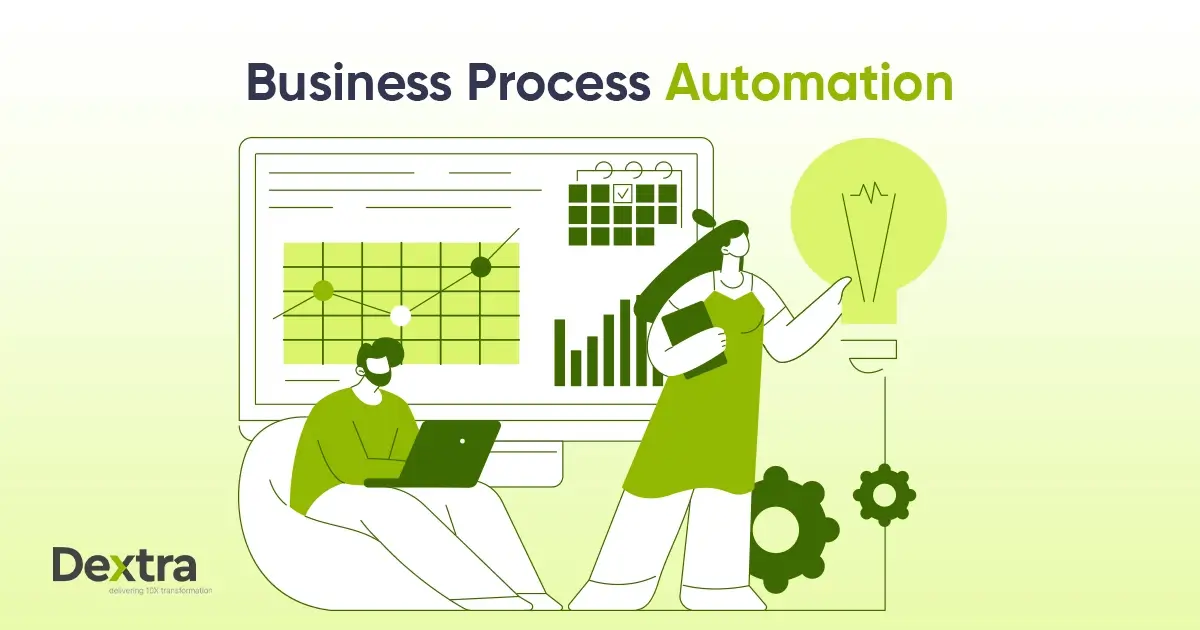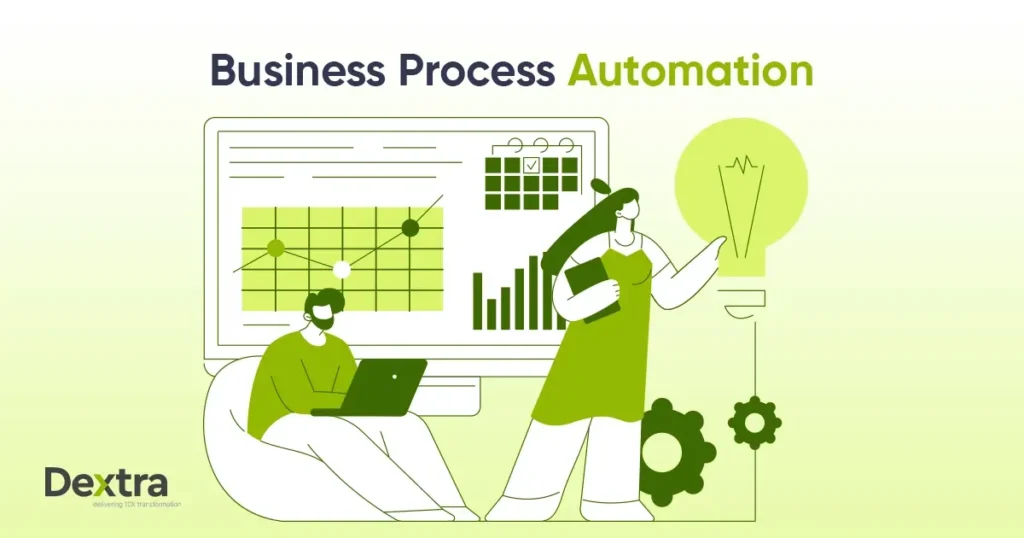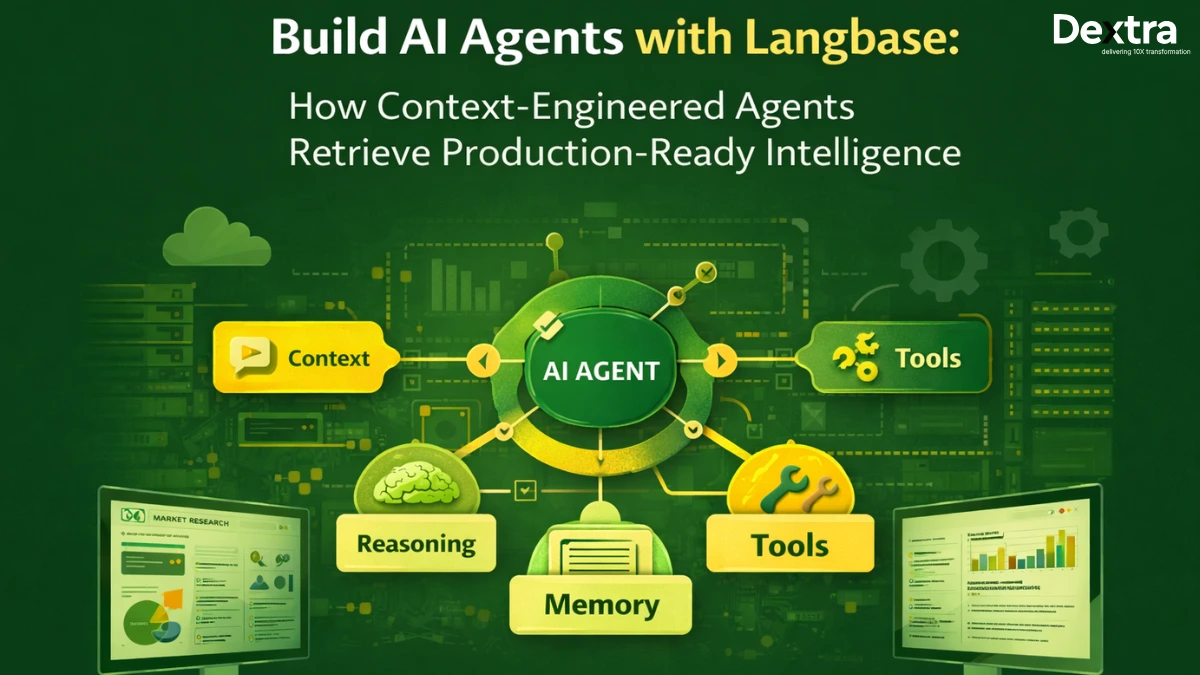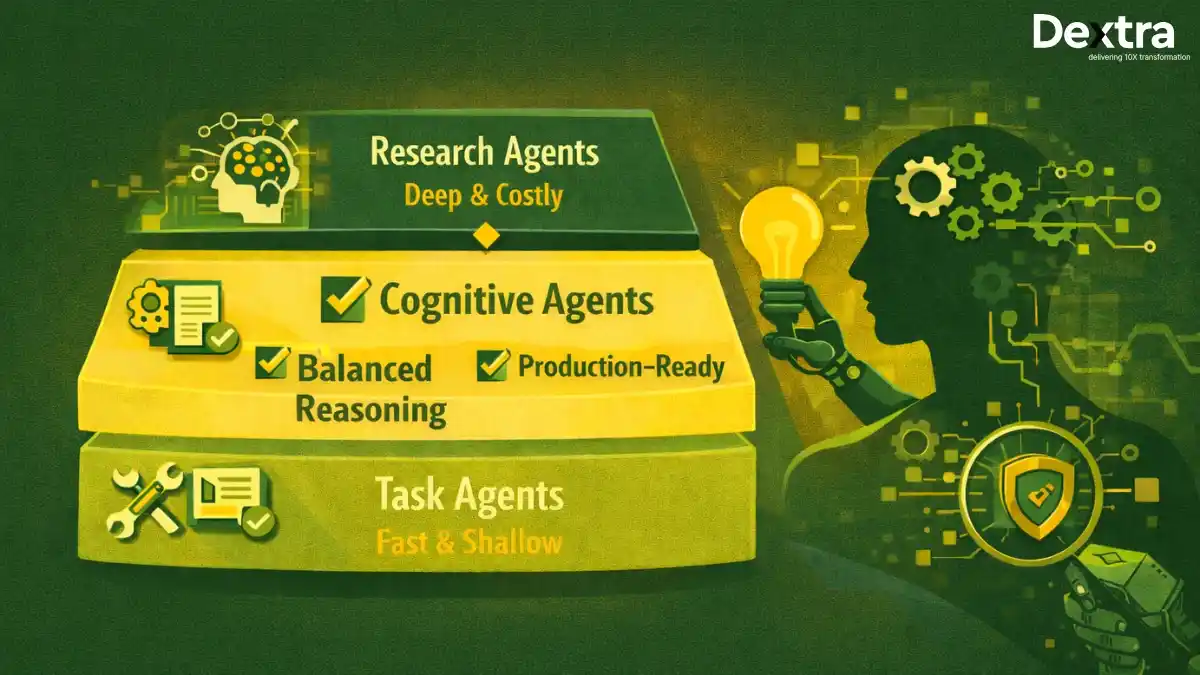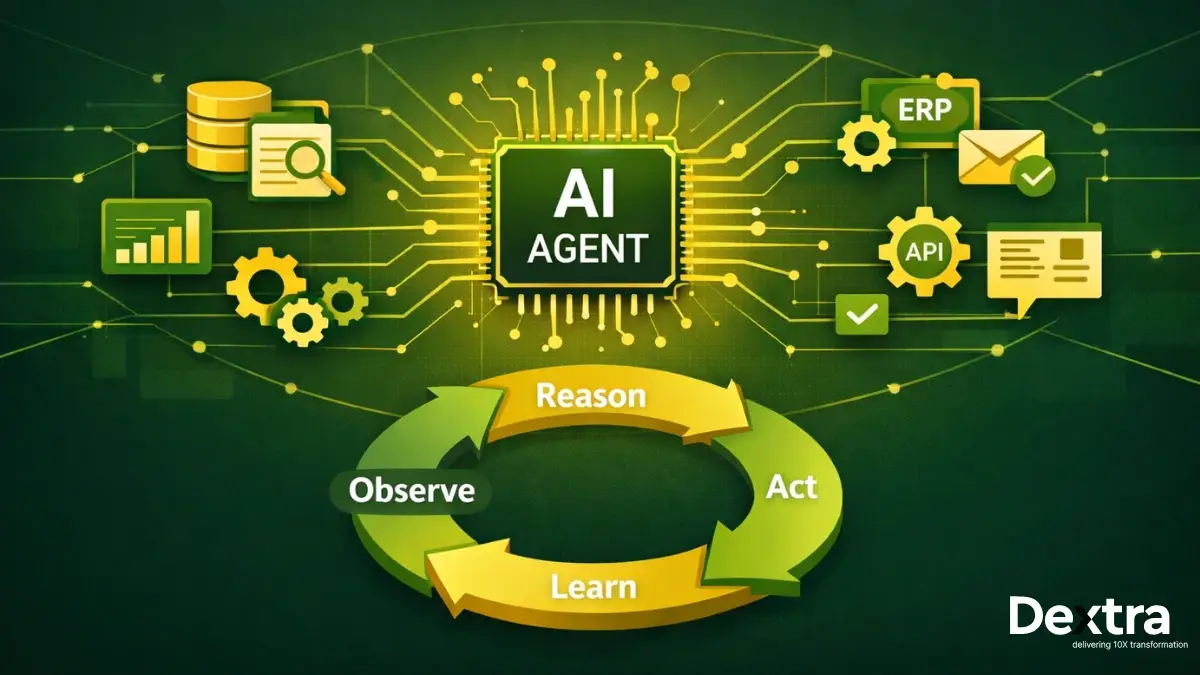Businesses are interested in solutions to enhance their productivity and streamline everyday tasks without incurring high-end costs. One of the most effective strategies for achieving all this is Business Process Automation (BPA). Through the automation of repetitive and manual tasks, businesses can increase their efficiency, reduce errors, and let employees focus on high-value work.
Automation is the key to digital transformation, be it in small businesses or large enterprises. This article shares business process automation in detail, its implementation, and why it’s important for modern organizations.
What is Business Process Automation?
Business Process Automation (BPA) can be defined as the use of technology to automate repetitive or recurring business activities that are otherwise performed manually. These tasks range from basic administrative duties such as data entry, and customer follow-ups to complex workflows such as supply chain management and financial operations.
Through automation, companies can decrease the amount of human intervention required in daily operations, thus increasing productivity, enhancing accuracy, and allowing teams to focus on strategic and value-added initiatives
Business Automation is a critical part of any company, as it encompasses the way for technology to help the companies perform tasks and manage operations with minimal human intervention. BPA is applicable to any industry, to help companies reduce inefficiency, optimize workflow and enhance delivery service.
Benefits of Business Process Automation:
1- Increased Efficiency: Automation also allows businesses to finish tasks quickly by removing the constraints linked with manual procedures. Tasks that take several days or hours can be finished within a few minutes.
2- Cost Savings: BPA reduces the requirement of human labor and eliminates operational costs. Automating repetitive tasks helps businesses to achieve more in less time with few resources.
3- Improved Accuracy: There is always a possibility of human error, particularly when dealing with repetitive tasks. BPA eliminates the chances of errors to increase the reliability of data and outcomes.
4- Scalability: As businesses scale up, managing the increasing workloads becomes challenging. Automation offers scalability to enable companies to handle more tasks without the need to extend their resources.
5- Enhanced Compliance: BPA guarantees consistent execution of business procedures, meeting industry standards and regulatory requirements. This eliminates the risk of potential penalties and non-compliance.
In short, BPA helps businesses to achieve more agility and responsiveness, in a highly competitive and fast-changing market.
The Difference Between Business Automation and Enterprise Process Automation
While business process automation is a generic term used for describing the automation of different business tasks, enterprise process automation refers to automating large and advanced workflows across the entire organization. The main difference between the two lies in the scale and scope of the procedures being automated.
Business Automation vs. Enterprise Process Automation:
Business Automation focuses on different tasks and functions within an organization. For example, small to medium-sized businesses can automate customer support chats, invoicing, and marketing communications. All these automations are isolated from each other and help to focus on efficiency in their respective area.
Enterprise Process Automation (EPA)
on the other hand is about the automation of large-scale operations, often stretching to multiple departments and functions. In large enterprises, the EPA handles complicated interconnected procedures that require advanced tools and coordination across departments. For example, enterprise process automation can be done to automate a business’s supply chain
management, customer relationship management (CRM), or enterprise resource planning (ERP).
A small company may use business automation to send automated follow-up emails to customers and leads, whereas a large enterprise can implement enterprise process automation for managing global inventory systems or automating procurement procedures across different countries.
Both business and enterprise process automation aims to achieve the same goals such as efficiency, accuracy, and scalability. However, enterprise process automation needs more advanced tools, deeper integrations, and a strategic approach for managing larger and more complex work procedures.
Examples of Business Process Automation and Enterprise Process Automation
Automation helps in transforming a wide range of business functions from small routine tasks to large-scale, cross-departmental operations. Given below are some examples of how the businesses can implement automation in the BPA and EPA context.
Examples of Business Process Automation (BPA):
1- Email Marketing Automation: Businesses use tools such as Mailchimp or HubSpot for automating email campaigns. This includes sharing newsletters for promoting offers and follow-up emails based on customer behavior such as completed purchases and abandoned carts.
2- Invoicing and Billing: Automated invoicing tools can generate, share, and track invoices to free up time that is otherwise spent on manually processing and following up on payments.
3- Customer Support: Most agencies deploy chatbots for handling common customer queries. These bots answer frequently asked questions, direct customers to appropriate resources, and increase issues requiring human help.
4- HR Onboarding: Automates the employee onboarding procedure. It shares welcome emails, sets up accounts, and organizes training schedules automatically to streamline HR tasks.
5- Social Media Management: Tools such as Buffer or Hootsuite help businesses schedule and automate social media posts in order to maintain a continuous online presence with minimum manual effort.
Examples of Enterprise Process Automation (EPA):
1- Supply Chain Management: Large businesses automate inventory tracking, order processing, and shipment logistics through ERP systems such as SAP or Oracle. This decreases delays, reduces errors, and ensures efficient supply moves through the value chain.
2- Enterprise Resource Planning (ERP): Automating entire resource planning across departments including procurement, finance, production, finance to logistics for enhancing decision-making and operational efficiency.
3- Financial Reporting: Automating financial reporting tasks pulls data from different departments. It generates reports and ensures compliance with financial regulations in real-time.
4- Customer Relationship Management (CRM): Large enterprises use CRM systems to automate and manage customer interactions, tracking leads and providing personalized experience at scale.
Automation within CRM systems includes everything from follow-up reminders to customer service workflows.
5- Human Resources (HR) Management: Large enterprises use HR automation tools for handling recruitment and onboarding employees, payroll processing, and performance tracking. By automating these complex time-consuming procedures, the HR team frees up time to focus on strategic tasks such as talent development.
4- Key Components of Business Process Automation
Implementing BPA successfully requires an understanding of the key components of an automation system. These components work together to create a seamless workflow allowing businesses to automate tasks efficiently.
Common Processes Automated through BPA:
1- Workflow Automation: The main focus of BPA is to automate the flow of tasks between departments and individuals.
For instance, an automated system may route documents for approval, send notifications to team members when a task is finished, and trigger the next step in the process automatically.
2- Data Entry Automation: Most organizations spend a significant amount of time manually entering data into systems. BPA tools automate the process of extracting and processing data from different sources to reduce errors and save time.
3- Task Assignment and Management: Automated systems automatically assign tasks on predefined rules and criteria for ensuring workflows move forward without any manual intervention.
4- Communication Automation: Automation tools can handle communication-related tasks, such as sending emails, reminders, or notifications. This ensures that employees, customers, and partners stay informed without requiring human involvement.
Tools and Software for BPA:
Companies have a wide range of automation tools to incorporate in automating their operations efficiently. Some examples include:
- RPA (Robotic Process Automation):
Tools such as UiPath, Automation Anywhere, and Blue Prism can be used for automating recurring tasks such as data entry, invoices, and payments or report completion. - AI-based Automation: AI technologies are applied to automate intelligent and data-driven decision-making. AI-powered chatbots and virtual assistants can handle customer interactions to help employees manage tasks efficiently.
- BPA Platforms: There are workflow automation programs such as Zapier, Monday.com, or Asana for businesses to automate operational tasks across departments and teams that trigger actions on different events automatically.
Choosing the Right Business Process Automation Solution:
Choosing the right business process automation solution depends on different factors, such as:
- Integration: The automation solution should integrate seamlessly with your existing workflow systems such as HR tools, ERP and CRM, etc.
- Customization: Businesses are in need of solutions offering customization options for custom tailor automation to their needs.
- Scalability: The selected solution needs to scale up to the expected business growth. This helps to automate additional workflow tasks and procedures as required.
- Support: Make sure the provider offers continuous support and updates for a smooth functioning system.
Why Your Business Needs a Business Process Automation Service?
Executing BPA is a complicated task and most businesses lack the required expertise to evaluate, design, and roll out automation solutions effectively. A business process automation service provider helps agencies navigate this issue to ensure BPA implementation.
Key Benefits of Hiring a BPA Service Provider:
1- Expert Evaluation: BPA service providers offer years of experience to the table, helping businesses to identify the procedures that are best suited for automation.
2- Tailored Solutions: A BPA service provider also provides solutions customized to a business’s particular requirements. This ensures that the selected automation tools are well-suited to the agency’s industry and operations.
3- Faster Implementation: A BPA service provider also helps streamline the entire BPA implementation process to ensure that the automated solution is up and running in no time.
4- Ongoing Optimization: BPA service providers also offer continuous support to aid businesses in fine-tuning their automation procedures and scaling them as the organization grows.
Possible Case Study Examples:
A large healthcare provider partnered up with a Business Process Automation service to automate its patient’s intake and appointment scheduling system can reduce 50% of the actual time spent on the manual data entry without compromising on patient data accuracy across the different departments.
A retail company used a business process automation service to automate its supply chain management. This helped them reduce the manual data entry by 80% and improved order fulfillment speed by 40%.
What Business Processes Should You Automate?
Not all business operations can be automated. Identifying the right procedures for automation is crucial to enhancing the benefits of BPA.
Ideal Processes for Automation:
1- Repetitive, Manual Tasks: Procedures and workflows that are repetitive and do not need any variation such as sending invoices, routine approvals, or data entry are best suited for automation.
2- Time-Consuming Tasks: Tasks that require a specific amount of time for completing document management can be automated to free up employee’s time. This helps them to focus more on the strategic activities.
3- Customer Service Functions: Automation also handles customer support tasks such as answering frequently asked questions and booking appointments through chatbots and automated systems.
4- Approval Workflows: Workflows for procurement, employee leave requests, or expense claims can also be automated to speed up the process and reduce the execution time of important tasks.
5- Sales and Marketing: Lead nurturing, customer segmentation, and follow-up emails can also make sales and marketing procedures efficient and effective.
Processes Less Suitable for Automation:
- Complex, High-Touch Tasks: Procedures requiring a high degree of human intervention, strategic decision-making, and creativity are not suited for automation.
- Highly Variable Tasks: Procedures changing frequently or needing a custom approach are not good candidates for automation. The rules governing automation may need continuous adjustment in such cases.
By focusing on the automation of the right procedures, companies can enhance their efficiency, reduce costs, and improve overall productivity.
Steps to Implement Business Process Automation
Implementing a BPA is more than just selecting a tool and configuring it. It needs a strategic approach to ensure a smooth transition for ongoing success.
Step 1: Identify Key Processes for Automation:
Start by evaluating the procedures within your company. Identify all the processes that are time-consuming, prone to errors, and recurring in nature. Select those tasks that would benefit from automation and prioritize them for initial implementation.
Step 2: Choose the Right Business Process Automation Solution:
Once the procedures are identified, select the right BPA solution that aligns with your agency’s needs. Select tools that are scalable, customization, and have integrative capabilities.
Step 3: Collaborate with a Business Process Automation Service Provider:
Businesses that don’t have in-house expertise can recruit a BPA service to ensure a successful implementation. Their team would guide you through the process of selecting the right tools, designing the workflow, and deploying the automation solution.
Step 4: Monitor and Optimize the Automated Processes:
Once all the automation tools are in place and working, track their performance. Look for issues that can arise and optimize them further to ensure smoothness of Operations. As your business grows, refine your BPA system and scale it along.
Common Challenges in Business Process Automation
Although BPA provides various benefits, it also has several challenges that must be managed carefully to ensure success:
Integration with Legacy Systems:
One of the most common challenges most businesses face is the integration of automation tools with outdated systems. To overcome this challenge, businesses need to pick automation tools that offer seamless integration with existing platforms or upgrade their system for compatibility with the automation tools.
Employee Resistance to Change:
Employees can also be hesitant to embrace automation due to the lack of the necessary knowledge required for handling it or even a fear of job loss. To counter this issue, companies must offer detailed training to emphasize that a BPA would only perform the redundant tasks which would help them to focus more on the other strategic tasks.
High Initial Costs:
The cost of Executing BPA solutions is high for some businesses. However, it’s important to focus on the long-term ROI and the savings generated by enhancing work efficiency and error reduction.
Future Trends in Business and Enterprise Process Automation
The future of BPA is exciting with a lot of possibilities due to the emerging new trends and technologies.
AI and Machine Learning in BPA:
The integration of artificial intelligence and machine learning in BPA systems would further enhance automation. These technologies will further enable it to execute data-driven decisions based on predictive analytics. For instance, AI-powered chatbots would not just answer the common questions but would also learn from the interactions to offer accurate answers to the more technical questions.
Low-code and No-code Automation Tool:
A growing trend in BPA is the rise of low to no-code automation platforms. These tools make it possible for non-technical employees to create and deploy automated solutions without needing extensive IT assistance. This makes automation more accessible for businesses on a limited budget.
Hyper Automation:
Hyper Automation refers to the advanced technology usage such as AI, ML, and RPA for automating as many procedures as required within an organization. Hyper Automation is beyond basic automation and includes advanced procedures such as process mining, workflow analytic,s and the integration of multiple automation tools across the entire enterprise.
Conclusion
Business process automation is an important strategy for businesses looking to stay on top of their competition. Automating recurring tasks results in improved data accuracy and freeing up important resource time. This helps organizations to run efficiently and effectively. In short, BPA when applied at the business or enterprise level can transform operations, enhancing productivity and business growth.
Companies interested in exciting BPA must identify the procedures that are to be automated, select the right tools and if need be, recruit a business process automation service to ensure a successful implementation. As new technologies emerge in the form of AI, BPA’s become even more powerful tools for businesses of all sizes.
So embrace automation today to position yourself for long-term success and navigate the challenges of tomorrow with enhanced efficiency and agility.
